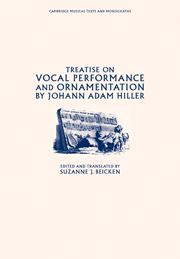Book contents
- Frontmatter
- Contents
- Acknowledgments
- Translator's introduction and commentary
- Note on the text and musical examples
- TREATISE ON VOCAL PERFORMANCE AND ORNAMENTATION
- Preface
- Dedication
- 1 On the qualities of the human voice and its improvement
- 2 On good performance and how to use the voice
- 3 On good performance, with regard to text and music
- 4 On good performance, with regard to ornaments
- 5 On good performance, with regard to passaggi
- 6 On good performance, with regard to the various genres of vocal forms and in consideration of performing in various places
- 7 On cadenzas
- 8 On arbitrary variation of the aria
- Appendix
- Bibliography
- Index
4 - On good performance, with regard to ornaments
Published online by Cambridge University Press: 22 September 2009
- Frontmatter
- Contents
- Acknowledgments
- Translator's introduction and commentary
- Note on the text and musical examples
- TREATISE ON VOCAL PERFORMANCE AND ORNAMENTATION
- Preface
- Dedication
- 1 On the qualities of the human voice and its improvement
- 2 On good performance and how to use the voice
- 3 On good performance, with regard to text and music
- 4 On good performance, with regard to ornaments
- 5 On good performance, with regard to passaggi
- 6 On good performance, with regard to the various genres of vocal forms and in consideration of performing in various places
- 7 On cadenzas
- 8 On arbitrary variation of the aria
- Appendix
- Bibliography
- Index
Summary
In considering what was said about accents in the previous chapter, it becomes apparent that all musical ornaments are essentially accents and actually should be used to emphasize certain notes and syllables. If one pays attention to their application, nature, and characteristics from the point after a note to the longest melismatic extension, then one will be convinced of the above statement. In the past, appoggiaturas were already called accents, which is still the practice in France. Mattheson also refers to them by that name in Der Vollkommene Capellmeister. Nevertheless, aside from accentuation, additional reasons for appoggiaturas can be given. Agricola lists four reasons: (1) to give the melody greater connection; (2) to fill in apparent gaps in the movement of the melodic line; (3) to make the harmony richer and more diverse; and finally, (4) to add vividness and brilliance to the melody. Whenever a note or syllable in need of an accent is ornamented, one or another of these uses will occur.
Whatever reason there might be for their use, ornaments are not essential to the melody but are rather arbitrary embellishments which, for our taste, have become a necessity. In the past they were left completely to the discretion of the singer and no one took the trouble to indicate or write them out. Therefore, Tosi expresses indignation at those composers who, by indicating appoggiaturas, deprived the singers of the privilege to ornament and show their ingenuity.
- Type
- Chapter
- Information
- Publisher: Cambridge University PressPrint publication year: 2001



